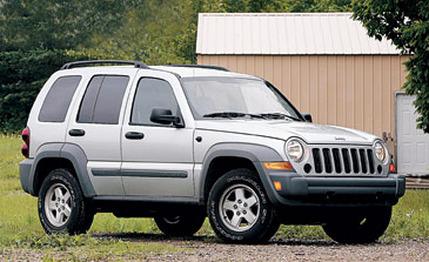 Short Take Road Test
Short Take Road Test
During the '80s, when the news section of this magazine was called FYI, it included a semiregular subcategory called Diesel Clatter. In the era that followed the fuel hysteria of the '70s, diesels were offered by a number of automakers, and we dutifully passed the info along to you. This included the first-ever Jeep smoker, a 2.1-liter Renault turbo-diesel option offered for the Jeep Cherokee from 1985 through '87.
Without wishing to be unkind, this latest Jeep Liberty engine option reminds us of that old FYI heading. In an era when most compression-ignition engines are almost as smooth and quiet as their gasoline counterparts, the Liberty's 2.8-liter turbo-diesel four takes us back to those innocent days when exceptional fuel economy could make us overlook drawbacks, particularly the racket that went with any oil burner. Light up the Liberty's engine, close your eyes, and suddenly you're riding in a Mercedes diesel taxi, Stuttgart, circa 1985. Clatter spoken here, Dieter. Jawohl.
A little background. With the development of common-rail fuel systems, diesels have changed dramatically in the past two decades. Thanks to massive system pressures-more than 20,000 psi is not uncommon, compared with 50 to 80 psi for gasoline port-injection systems-the fuel is more finely atomized, promoting a more complete and controlled burn, and that pays off with higher efficiency and reduced emissions. Supplied by DDC Cento (previously VM Motori), a subsidiary of Detroit Diesel in Cento, Italy (and 49 percent owned by DaimlerChrysler), the Liberty's turbo-diesel is consistent with most of the common-rail parameters. The iron-block, aluminum-head DOHC 16-valve four has a compression ratio of 17.5:1, with fuel-rail pressure pegged at 1600 bar-about 23,000 psi. With its Garrett turbocharger blowing at max boost-26.5 psi-the engine develops 160 horsepower at 3800 rpm and 295 pound-feet of torque at 1800 rpm.
This is considerably less horsepower than you get from the Liberty's optional 210-hp, 3.7-liter V-6, but considerably more torque: 60 pound-feet, peaking 2200 rpm lower. And it's this trait-low-down grunt-that makes this or any other diesel appealing: grunt, plus relatively high fuel economy. In the case of the Liberty diesel, you get distinctly higher EPA fuel-economy ratings than those of the gas V-6-21 mpg city, 26 highway versus 17/22 (or 18/22 with a manual transmission). Jeep expects the diesel will get about 25-percent-better fuel economy than the V-6 in real-world driving. We got 20 mpg with the diesel, which was exactly a 25-percent improvement over the 16 mpg we achieved with the V-6.
You also get the same towing capacity as that of the 3.7 V-6-5000 pounds, heftiest of all the cute utes. And you get similar acceleration. Our turbo-diesel tester rattled to 60 mph in 10.1 seconds compared with 10 flat for the Liberty Limited Edition we tested in January 2002 ("Canyon Cubs") and was quicker in the quarter-mile: 17.3 seconds versus 17.5.
No one would characterize this little Jeep as fast, but the turbo motor spools up quickly and holds its own in urban traffic. The engine's power traits match up well with the five-speed automatic transmission, the latter yielding smooth up- and downshifts, and it lopes along at freeway speeds without undue strain.
But there's the clatter problem. From the moment of light-off, the Liberty's four begins emitting a symphony of rattles and growls, richly varied, depending on throttle position, but incessant. We've seen numerous recent diesels that allowed us to ignore the nature of their ignition systems. This is not one of them. The Jeep folks cite a number of reasons for the extra racket, namely, the simple fact that the four-banger has large 694cc cylinders that create a lot of noise. Plus, the engine sits close to the Liberty's passenger compartment, and the exhaust system exits from the back of the engine between the motor and fire wall.
Like other sparkless engines, you pay a premium for this cheerfully raucous powerplant: $3695, including the required five-speed automatic and a more sophisticated four-wheel-drive system with a four-high open mode. The V-6 option in the same model costs only $850, and you don't have to upgrade to the automatic. This, along with the fact that No. 2 diesel fuel is currently more expensive than gasoline, makes it hard to see an advantage to the diesel. On the other hand, for those who appreciate internal combustion, there's something uniquely appealing about the Liberty diesel. Appealing, we should add, almost exclusively to guys, particularly guys living in the wide-open West, according to DaimlerChrysler. This probably proves, once again, that women have better sense. But there are enough of these guys to account for about 6000 sales per year, a little beyond DaimlerChrysler's expectations.
One cautionary note: If you find the notion of a Liberty diesel appealing, buy soon. Barring some dramatic change in technology, passenger-car diesels will disappear by 2007, when Tier 2 emissions regs come on in full force. No current passenger-car diesel meets this new standard.